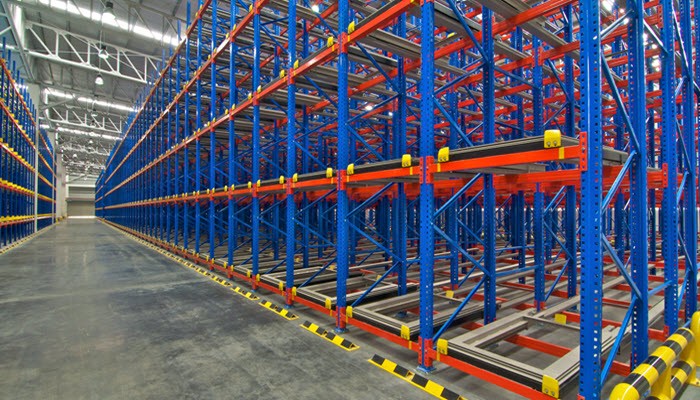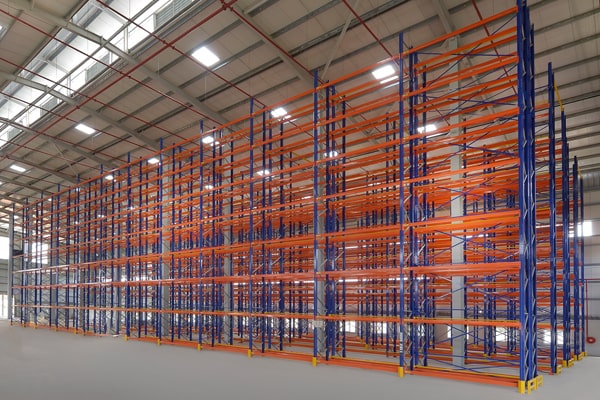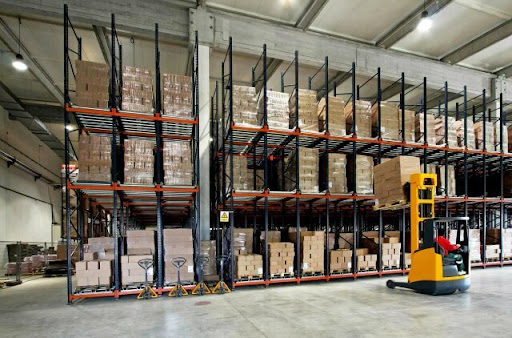What Is Pallet Racking? The Ultimate Guide
What is Pallet Racking?
Pallet racking is an easily accessible, space-optimizing alternative to other forms of storage systems. These systems allow businesses to utilize their otherwise unused vertical space in a comprehensive array of racking.
Companies large and small (warehouses in particular) choose pallet racking as a way to efficiently store their products.
Continue reading for an in-depth guide on pallet racking, its uses, safety considerations, building information, and more.

What is Pallet Racking?
Pallet racking is a storage system that is designed to accommodate pallets of items. Each of the pallets sits in horizontal rows on several vertical levels. Instead of expanding the building to create additional space, warehouses can adopt a pallet racking system that makes extra storage out of vertical space.
Many modern warehouses, retail centers, manufacturing facilities, and distribution facilities use pallet racking as a storage system. The increased density of these systems is appealing to facilities that need an efficient storage system that easily handles additional stored goods without sacrificing accessibility.
What is the Purpose of Pallet Racking?
Pallet racking systems create additional overhead space for palletized material storage. They conveniently free up floor space, increasing product accessibility. These systems are:
Flexible
Durable
Compatible with wide ranges of weight
Since building expansion is generally unnecessary, they are a cost-effective alternative. Warehouse employees can access palletized materials using a forklift truck that can easily maneuver within the rows. Easy accessibility to the rows shaves off stock-picking time, thus increasing warehouse efficiency.

How Does Pallet Racking Work?
Each type of pallet racking system is slightly different from the last, but they all support the same general idea. Gravity-fed rails facilitate pallet racking. For example, push-back rack systems sit at an angle, so the others slide forward when employees remove the front pallet.
Heavy-duty beams support the pallet racks and connect to the uprights, which are columns or upright frames that serve as side supports.
The beams determine the system’s width and create the rack’s shelves through the connection points with the uprights.
Beams are available in two different styles:
- Step beams
- Box beams
The type of beam enables the use of wire decking or other optional supports. The height of pallet rack beams is adjustable and can be changed to meet varying needs. They’re easily removable, so future changes are doable.
What Are the Major Uses of Pallet Racking?
Pallet racking systems are primarily used for additional storage and provide numerous benefits. They take advantage of unused vertical space. Many warehouses can accommodate high bays due to their high ceilings. Inventory is easily accessible and organized since it is stored up instead of out.
Additionally, warehouses tend to experience fewer damaged goods since they can contain goods without damaging them. The pallets are not stacked on each other, which could damage inventory through the contact, and are instead situated on each level.
Beams and uprights are typically made of high-quality materials, making them a sturdy and durable choice for storing items. Safety devices, like motion and proximity sensors or alarms, are available to promote safety further.

Main Types of Pallet Racking for Warehouse Storage
There are multiple racking configurations and designs that warehouses can choose from. For the most part, rack systems divide into two applications: high-selectivity, low-density, and low-selectivity, high-density. Popular choices include selective, double deep, very narrow aisle, push-back, drive-in, and pallet flow. The latter three are high-density applications, while the first three are high-selectivity, low-density.
-Selective: Selective racking is typically made up of spacious shelves capable of holding a single row of inventory. This choice is the most popular in the industry, given its efficiency and versatility.
-Double deep: These racks consist of two rows of selective racking, one right behind the first. Storage capacity increases by up to 40%, and it is an affordable way to create high-density storage.
-Very narrow aisle: These systems operate with the idea of improving space utilization while retaining high levels of selectivity. They require a forklift capable of sideloading, as the additional maneuvering space seen in other systems is minimal.
-Push-back: Push-back racks sit on carts that cycle the product forward when the pallet in front is removed. These systems may be up to five carts deep, and pallets are fed and retrieved from a single aisle.
-Drive-in: These rack systems increase storage capability by up to 75% compared to selective racks, given that they don’t require as many aisles. Drive-in racks are the most high-density storage option available.
-Pallet flow: Also known as gravity flow racks, these systems work via a sloping system that moves older products from the back to the front. New pallets are added to the high end, moving as the products in the front are removed.
Safety Considerations Before Installing Pallet Racking
Properly installing pallet racking systems is imperative for employee safety and product security. Before installing pallet racking, there are several things to consider to promote safety, including:
Floor-type
Pallet racking will secure better to specific floors. Concrete, linoleum, vinyl composition tile, and epoxy are common floor types in warehouses. For the most part, pallet rack systems are secured to concrete, in which case concrete wedge and strike anchors make the job easier.
Sloped floors
If the warehouse has floors greater than 0.5-inch in 10 feet of height that differs from true parallel with gravity, additional changes may need to happen. Ensure that the rack designer is well aware of the slop gradient as nominal loads and other forces due to sloping floors could present a problem.
Seismic activity
Warehouses located in regions that experience seismic activity should perform design checks for the loading check. The American Society of Civil Engineers (ASCE) assigns each area a seismic design category (SDC).
Inspections
Once the installation is done, the person in charge, such as the manager or owner, needs to develop an inspection schedule. Qualified individuals who have the necessary certifications should be the only ones to handle annual inspections.
Managers should establish a routine check schedule to ensure that there aren’t any security concerns that could pose a problem. The manager may assign a team to conduct these inspections routinely. Any concerns should entail a professional assessment and be remedied immediately.
Impact protection
The design of the base plates and anchor system can withstand force, but they are still prone to impact from various heavy-duty machinery. Consider adding additional reinforcements to withstand blunt force from impacts, such as a higher quantity of anchor bolts, column protectors on base plates, column guards, and the like.
How to Build Pallet Racking
Building pallet racking is relatively simple. Bolting the pallet racking system to the floor is slightly more complex, as it requires specific torque on each of the bolts, which we will address in the next section.
Consider the teardrop pallet rack building process:
- First, start by securing the upright into position.
- Next, secure the beam into place on the upright, at whichever level is appropriate.
- Secure the second upright onto the opposite end.
- Complete the same process with the second beam, securing it into place on each upright.
- Situate the wire decking onto the beams, fitting the lip of the wiring over the beam.
Importance of Warehouse Pallet Racking System
Proper installation and thorough inspections are critical to constructing a safe, secure pallet racking system. Once the system installation is complete, a professional appraisal is best. Professionals can catch any potential issues that could present safety or security hazards.
Generally, pallet racking systems are secured to the wall, the floor, or each other for additional stability. When attaching these systems to the floor, you will need to install Dyna bolts:
-Drill necessary holes that are the same diameter as the Dyna bolt.
-Insert the bolt into the hole, place the washer on, and thread the nut several turns.
-Insert the bolt into each hold through the baseplate of the upright rack, then hammer the anchors into each hole to the desired depth.
-Tighten each of the nuts with a torque wrench, ensuring they are tightened enough to meet the requirements.
After you finish bolting the racking system to the floor, ensure that all bolts and fittings are properly tightened.
Conclusion
Pallet racking systems are an excellent option to optimize storage space. They improve product density and make inventory easily accessible. Unlike other storage systems requiring vast amounts of floor space, these systems utilize otherwise unused vertical space. Additionally, they are relatively affordable in comparison to the alternative, which may result in building expansion.
However, pallet racking systems must be properly installed and inspected, or they will not serve their purpose as efficiently and safely as they should. By ensuring that the system meets the necessary requirements outlined by local building codes and safety requirements, the pallet racking system can do what it is designed to do.
At The Safety Source, we follow all safety requirements, building codes, and provide the best quality pallet racking systems in the Detroit region. Fill out our form or give us a call today if you need help with a pallet racking project.







